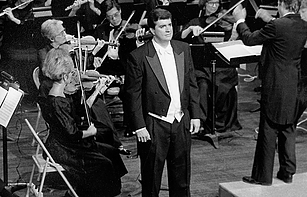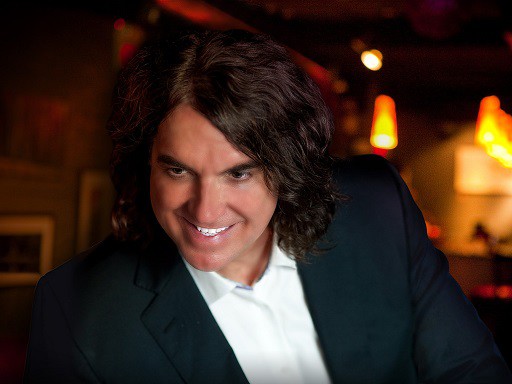
Blest with a very dynamic and sturdy vocal instrument, and a careful study of the Italian Bel Canto & Appoggio breathing technique, Federico has stunned audiences worldwide with the strength and beauty of his range, alacrity & warm, golden, Italianate timbre.
L’IDEA MAGAZINE: You affirm on your website that you started your singing career later in life than most professional singers. Could you elaborate on that? What was your inspiration?
FEDERICO CARDELLA: I was busy raising two daughters, Lindsay & Rebekah – life got in the way of a full time career in Opera. I worked to put them in College – one is a PA Dermatologist and graduate of Wake Forest, the other is a Theater actress and singer and attended to Royal Academy of Dramatic Arts in London.
I went to a Luciano Pavarotti Concert in Orlando and heard him sing Tosca’s Recondita Armonia by Puccini as his first selection – I thought it was so beautiful I cried and vowed to my wife that I wanted to try and learn to sing like this!
L’IDEA MAGAZINE: You had opera voice teachers who were renowned and respected, such as Vera Rosca, Jerome Hines, Ken Smith and Franco Corelli. What did you take from each of them?
FEDERICO CARDELLA: This is what I learned:
Vera Rosca – not to “spread”(ahhhhh) on the tenor notes E-Ab on the Ah vowel but open the throat more to round the sound like Domingo: awe.
Jerome Hines – taught me the best scales to practice- especially as I age, to prevent the chords from “bowing” and to keep the voice young sounding and strong even into my 80’s…
Ken Smith -through a series of seemingly animalistic vocal exercises, he was the first to teach me how to achieve true “squealo” ( i.e. -the primitive scream in the head) and head voice from Ab to Db – to listen, achieve and appreciate the richness and baritone space in the middle voice. He was first to teach me the tenor physical sensation of the voice through esoteric Caruso type teaching method.
Franco Corelli – take risks- be imperfect and crack if you must – but NAIL the high notes in the head – use the full thrust of air from the appoggio technique – it takes a certain body of diaphragm/largeness, large lungs, small chords and a big enough skull to ring the notes in the head to sound dramatic and dark – it’s the intangible result of great technique mixed with a linebacker’s body and skull with women size chords – basically there are few dramatic tenors because they are freaks of nature! lol It seems most people today settle for the “neck tie” El perfecto micro tenors – and the larger bodied tenors are too covered and sing too Germanic/Wagnerian. Caruso/Corelli/Pavarotti/Bjorling (the Swedish Caruso) represented the best in tenor singing – all of these men were massive in girth of diaphragm and had the strength of a rugby player when they sang. Corelli, most of all, taught me that the voice was strong – that you train it like a horse – not to pamper it like these thin sounding but “perfect” sounding micro tenors do today. I tell you there is no primitive scream or thrill in them and if their “polished” voices were put next to any of the above greats – these peep squeaks would not be heard!
L’IDEA MAGAZINE: Who is the singer who influenced you the most and why?
FEDERICO CARDELLA: Luciano Pavarotti – because he showed me how to sing brightly/lightly in the middle voice with the least effort at almost speaking voice energy – in Italian called “Parlando” technique
Franco Corelli – because he taught me how to achieve in Caruso’s form the true Voce di Testa (Ringing voice in the head/skull) the primitive scream in the head – to go through the passaggio easily with the open throat and sub glottal breath support – there are only a handful of Tenors/Sopranos in the world today who truly sing like Joan Sutherland, Maria Callas/ Corelli & Mario Del Monaco, Mario Lanza etc.
Sadly, most modern main stage tenors today are boring to listen to- though perfect in their pitch and placement they sound weak when nailing the high notes or just too covered – they do not have the clarion/clear ring at the top with the baritone power- pretty singing – but not powerful at all. There is great risk to sing BOTH brightly and with full baritone power at the top -I have heard none sing like young Carreras or as Pavarotti/Jussi Bjorling or Corelli in their prime. Yet the opera buff pundits say this small, new breed of some tiny, highly amplified, South American tenors singing a bunch of amplified hi C’s is better than the Italian large men greats. lol!!!! I rather hear a Corelli sing an exciting high A over their bright and thinned (but perfectly paced) high C or Db any day!
These little, small diaphragm tenors are going around accepting that they are the best tenors of all time by their shills in the Opera press. Corelli’s manly, heroic and unamplified tenor voice would blow ten of the Mets best tenors off the stage with one B natural if put side by side. They all only go to prove that the Golden Era of Opera is long dead. It is full of perfectly small, uninspiring perfect tenor voices – there is no soul weight or heroic sound in them- they strut around like peacocks – and the younger opera crowds don’t know any better. Sure, the older tenors applaud them too. They are trying to promote the industry. But in private they don’t approve.
L’IDEA MAGAZINE: What opera character would you most intrigued to perform and why?
FEDERICO CARDELLA: Mario Cavaradossi, the painter in Puccini’s Tosca- I love all the drama in this 1800’s setting, but most of all- being a Verde/Puccini tenor – I am affixed to the tenor arias (equally so with Nessun Dorma – Turandot) Recondita Armonia and E Luce Van Le Stelle are my two favorite arias to hear and sing and why I was inspired to become an operatic tenor in the first place.
FEDERICO CARDELLA: In my opinion, the London Symphony is the best recording orchestra in the world, which is why George Lucas, Cameron and so many others use them for their movie sound tracks- when I recorded with them we had 100 pieces, but they all played as one unit live. The 300 year old Brass sounds very powerful and unique, not to mention all the Strats in the violin section. That’s why Star Wars sound s like Star Wars!
FEDERICO CARDELLA: Yes, I had to learn to sing more contemporary, but without leaving my own voice to imitate Sting, or Michael Bolton or Bryan Adams or Zedd … The main vocal adaptation is to tighten up or shorten wave lengths of vibrato- especially on end notes- the big operatic wobble /vibrato not permitted. I had to raise my normally dropped larynx more in the passaggio and head voice, but still keeping the power tenor with the power groove; I gained a lot of respect for pop singers when I first tried this!
FEDERICO CARDELLA: Entertainment = HOPERA – as it is called – I like the revolutionary and evolutionary convergence of the two styles – EDM/ Hip Hop with Opera and this can keep our young people still interested in the arias of old because it is the digital sound they have grown so accustomed to. So yes – a cultural invasion of a new genre I call (and now trademarked) HOPERA.
L’IDEA MAGAZINE: In some of your recordings, there was the participation of your daughters Lindsay as flutist and Rebekah as singer in duets with you. How emotional was that experience?
FEDERICO CARDELLA: That is the best experience any performer can have – to record or perform live with family and the people you love the most. Very heart warming and cherished memories- forever recorded. Love my girls.
L’IDEA MAGAZINE: What new projects are you working on at the moment?
FEDERICO CARDELLA: A Broadway Musical
L’IDEA MAGAZINE: What is your most ambitious goal?
FEDERICO CARDELLA: To do a musical and then a major motion picture to follow- I have nearly finished the script for both…
L’IDEA MAGAZINE: Where are you going to perform in the next few months?
FEDERICO CARDELLA: On Broadway – we are close to closing a deal with a Theater for late summer 2016.
Note: to sample some of his wonderful music, visit www.federicomusic.com

